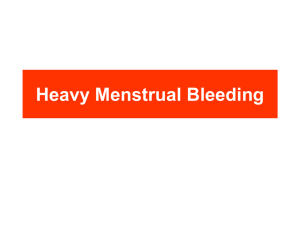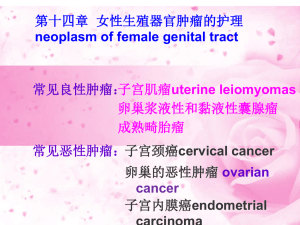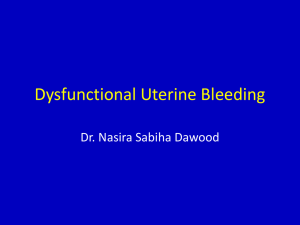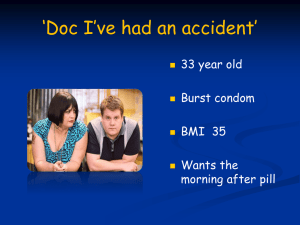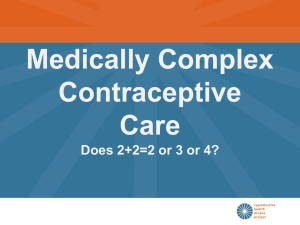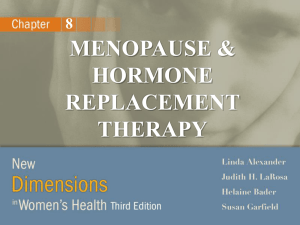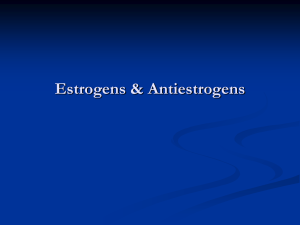Q Gynecology Review
advertisement
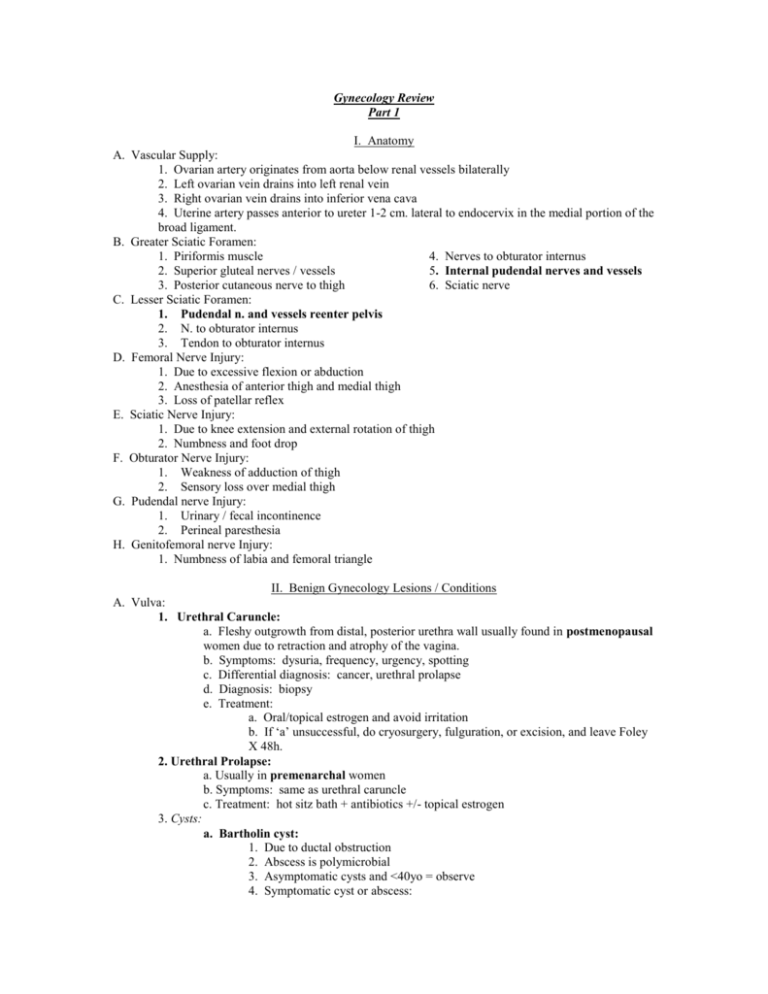
Gynecology Review Part 1 I. Anatomy A. Vascular Supply: 1. Ovarian artery originates from aorta below renal vessels bilaterally 2. Left ovarian vein drains into left renal vein 3. Right ovarian vein drains into inferior vena cava 4. Uterine artery passes anterior to ureter 1-2 cm. lateral to endocervix in the medial portion of the broad ligament. B. Greater Sciatic Foramen: 1. Piriformis muscle 4. Nerves to obturator internus 2. Superior gluteal nerves / vessels 5. Internal pudendal nerves and vessels 3. Posterior cutaneous nerve to thigh 6. Sciatic nerve C. Lesser Sciatic Foramen: 1. Pudendal n. and vessels reenter pelvis 2. N. to obturator internus 3. Tendon to obturator internus D. Femoral Nerve Injury: 1. Due to excessive flexion or abduction 2. Anesthesia of anterior thigh and medial thigh 3. Loss of patellar reflex E. Sciatic Nerve Injury: 1. Due to knee extension and external rotation of thigh 2. Numbness and foot drop F. Obturator Nerve Injury: 1. Weakness of adduction of thigh 2. Sensory loss over medial thigh G. Pudendal nerve Injury: 1. Urinary / fecal incontinence 2. Perineal paresthesia H. Genitofemoral nerve Injury: 1. Numbness of labia and femoral triangle II. Benign Gynecology Lesions / Conditions A. Vulva: 1. Urethral Caruncle: a. Fleshy outgrowth from distal, posterior urethra wall usually found in postmenopausal women due to retraction and atrophy of the vagina. b. Symptoms: dysuria, frequency, urgency, spotting c. Differential diagnosis: cancer, urethral prolapse d. Diagnosis: biopsy e. Treatment: a. Oral/topical estrogen and avoid irritation b. If ‘a’ unsuccessful, do cryosurgery, fulguration, or excision, and leave Foley X 48h. 2. Urethral Prolapse: a. Usually in premenarchal women b. Symptoms: same as urethral caruncle c. Treatment: hot sitz bath + antibiotics +/- topical estrogen 3. Cysts: a. Bartholin cyst: 1. Due to ductal obstruction 2. Abscess is polymicrobial 3. Asymptomatic cysts and <40yo = observe 4. Symptomatic cyst or abscess: 4. 5. 6. 7. 8. 1. 2. 3. 1. 2. 3. 4. a. Marsupialize b. Word catheter c. Biopsy/consider excision if frequent recurrences or >40yo b. Epidermal inclusion cyst: 1. Most common vulvar cyst 2. Results from infolding of squamous epithelium often after trauma or from embryonic rests or occlusion of pilosebaceous ducts of sweat glands 3. Treatment: a. Infected: apply heat b. Not infected: excise Nevus: a. 5-10% of melanomas are on vulva b. All flat junctional and dysplastic nevi should be excised with a margin of 5-10 mm Fibroma: a. Most common benign solid tumor of vulva b. Treatment: excision Lipoma: a. Second most common benign vulvar tumor b. Treatment: excision Hematomas: a. Conservative treatment with ice pack and pressure unless >10cm or expanding b. If expanding: explore and ligate vessel (often venous) Hidradenitis suppurativa: a. Infection of skin and subcutaneous tissue of apocrine sweat glands b. Treatment: topical steroids and antibiotics; if refractory, excision 9. Lichen sclerosus: a. Loss of rete pegs b. Treat with clobetasol c. Postmenopausal and children B. Vagina: Urethral Diverticulum: a. Epithelial projection arising from posterior urethra, congenital or acquired b. Symptoms: urgency, frequency, dysuria, 10% with dribbling c. Signs: expression of purulent material d. Diagnosis: voiding cystourethrography and cystourethroscopy e. Treatment: excisional surgery when not infected Inclusion cyst: posterior and lateral walls Dysontogenetic cysts: a. Gartner’s duct cyst- cuboidal nonciliated epithelium on anterior lateral wall in lower 1/3 of vagina b. Mullerian cyst- columnar, endocervical epithelium c. Treatment: if symptomatic, excision (may extend into broad ligament) C. Cervix: Polyps: endocervical or ectocervical a. Symptoms: intermenstrual bleeding b. Treatment: remove polyps with forceps, consider ECC + EMB Nabothian cysts: a. Retention cysts of endocervical columnar cells b. No treatment needed Cervical Myomas: a. Remove b. Difficult in hysterectomy secondary to distortion of ureter +/- uterine artery Cervical Stenosis: a. Secondary to surgery, radiation or infection b. Treatment: 1. Dilation under U/S 2. Laminaria Q month D. Uterus: 1. Endometrial Polyp: a. Stroma and glands b. Treat with D&C +/- hysteroscopy 2. Leiomyomas: benign smooth muscle cell tumors with fibrous tissue from degeneration a. Types: 1. Submucosal (bleeding) 2. Intramural 3. Subserosal b. Degeneration: 1. Hyaline (65%) 2. Myxomatous (15%) 3. Calcific (10%) 4. Cystic 5. Fatty 6. Red (acute) 7. ??Malignant c. Abnormal bleeding is secondary to abnormal microvascular growth pattern and function of vessels in adjacent endometrium E. Fallopian tubes: 1. Torsion 2. Paratubal cysts F. Ovary: 1. Follicular cyst: a. Most common cystic structure in normal ovaries b. Majority resolve spontaneously 2. Teratoma: a. Most common benign neoplasm of ovary age 0 – 19 b. Arise from single germ line – 46XX c. Treatment of choice is cystectomy 3. Brenner tumor: Usually benign and contain transitional epithelium (Walthard rests) 4. Serous cystadenoma: Most common benign ovarian neoplasm age 20-44 5. Fibroma: a. Most common benign, solid ovarian neoplasm b. Meig’s Syndrome: fibroma + ascites + right hydrothorax III. Pap Smears / Cervical Dysplasia A. Frequency 1. All sexually active women or women > 18yo need annual pap/ pelvic 2. After 3 consecutive normal annual paps, may do less frequently 3. After treatment for preinvasive lesions, evaluation q3-4 months X 1 year, then annually 4. After treatment for invasive lesion, evaluation q3-4 months X 2 yr then Q 6 month 5. Yearly after hysterectomy with mild dysplasia 6. Q 6 months after hysterectomy with severe dysplasia B. High Risk Factors: 1. Multiple sexual partners 5. Immunosuppressed 2. Early first intercourse 6. Smoking, drug, or alcohol abusers 3. Male partners with other partners 7. History of vaginal, cervical, or vulvar with cervical cancer dysplasia 4. HPV / HIV /HSV 8. Low socioeconomic status C. HPV: 1. Detected in > 90% of preinvasive and invasive lesions 2. 70% of invasive lesions contain HPV 16 or 18 3. Prevalence of HPV in women with normal paps= 10-50% D. Colposcopy: 85-95% accuracy with directed biopsy E. ECC: routine with colpo F. Conization (laser, CKC, or LEEP) indications: 1. +ECC 2. Pap/Colpo discrepancy 3. Inadequate colpo 4. Biopsy + for microinvasive CA 5. Cytological or biopsy evidence of premalignant or malignant glandular epithelium G. Atypical glandular cells on Pap: ECC / EMB + colpo H. Abnormal endometrial cells on Pap: EMB or fractional D&C (if no abnormality identified, consider extrauterine source) I. Epithelial Cell Abnormalities 1. Squamous Cell a. ASCUS b. LSIL=HPV, Mild dysplasia / CIN I c. HSIL=Moderate dysplasia / CINII, severe dysplasia / CIN III, or CIS 2. Glandular cell a. AGUS b. Cancer J. Management 1. ASCUS X 1 a. Repeat pap q 3-6 mths if reliable b. Colpo immediately if not reliable 2. ASCUS X 2: colpo 3. LSIL: a. Colpo, pap q 3-6mths b. If biopsy is consistent with pap may ablate or follow and if persists > 1 year, ablate c. If pap / colpo discrepancy, conization d. 15% progress to HSIL e. 60% regress spontaneously 4. HSIL: colpo/biopsy, then ablate K. Therapy: Recurrence rate 10% regardless of mode of treatment 1. Local excision 2. Cryocautery: NO or CO2 3. CO2 laser 4. LEEP 5. Hysterectomy: for some HSIL IV. Abnormal Uterine Bleeding A. Definitions 1. Dysfunctional uterine bleeding: no organic cause 2. Menorrhagia: >7 days or >80ml at regular intervals 3. Menometrorrhagia: >7 days or >80ml at irregular intervals 4. Polymenorrhea: regular intervals <21 days 5. Oligomenorrhea: intervals between bleeding vary between 37 days and 6 months 6. Amenorrhea: no menses X 6 months B. Etiology 1. Systemic disease (VWD, PT def., ITP, sepsis, cirrhosis, thyroid disease) 2. Reproductive tract disease (pregnancy, malignancy, anatomic abnormalities) 3. Dysfunctional causes (anovulatory or ovulatory DUB) C. Anovulatory DUB 1. Continuous estradiol leads to endometrial proliferation and without corpus luteum and progesterone no uniform sloughing occurs and outgrows blood supply 2. Postmenarchal and perimenopausal 3. Not associated with dysmenorrhea D. Ovulatory DUB 1. After adolescence or before perimenopausal E. Diagnosis 1. Hgb / HCT 5. Luteal phase progesterone or BBT or EMB 2. Serum Fe and ferritin 6. Hysteroscopy 3. HCG 7. Sonohysterography 4. Coags- adolescents, older 8. TSH women with systemic disease F. Management: Acute Bleeding 1. Oral or IV estrogen 2. OCP cascade: 1 tablet PO QID…, then switch to OCP QD G. Management after acute episode is controlled 1. If choose #1 above, add provera 7-10d, D/C to allow W/D bleed, then start OCP’s H. Anovulatory DUB 1. Provera 10d Q month x 3 months (adolescents) 2. OCP’s or provera x 6 months if do not desire fertility in reproductive age 3. Clomid if desire fertility 4. Levonorgestrel IUD I. Ovulatory DUB 1. NSAIDS (ibuprofen, mefanamic acid, naproxen) 2. Antifibrinolytic agents (EACA, AMCA, PAMBA) 3. Progestins 4. OCP’s 5. Danazol 12 weeks (weight gain, acne) 6. GnRH agonist (add back) 7. Combination J. Perimenopausal DUB 1. OCP’s 2. Provera days 15-25 + estrogen days 1-25 K. Surgical treatment 1. D&C if hypovolemic or >35yo and suspect cancer 2. Endometrial ablation: YAG laser, cautery, roller-ball, saline balloon; good for those who can’t have major surgery; do not use if desire future fertility 3. Hysterectomy: failed medical treatment V. Endometrial Hyperplasia A. Risk of progression to CA (rule of 3’s): 1. simple: 1% 2. complex: 3% 3. simple with atypia: 9% 4. complex with atypia: 27% B. Treatment: 1. No atypia a. Cyclic progestin 10-14d x 3-6 months or continuous progestin x 3-6 months b. Repeat EMB after treatment 2. Atypia a. Retain uterus: 1. Continuous progestin x 3-6 months 2. Repeat EMB after treatment b. Undesired fertility: 1. Hysterectomy 2. If high surgical risk, continuous progestin + repeat EMB VI. Endometriosis A. Endometrial glands and stroma in aberrant locations B. Etiology: 1. Retrograde menstruation 4. Coelomic metaplasia 2. Vascular / lymphatic dissemination 5. Iatrogenic dissemination 3. Immunologic changes 6. Genetic predisposition C. Symptoms: 1. Cyclic lower abdominal pain 3. Infertility 2. Secondary dysmenorrhea 4. Dyspareunia D. Signs: 1. Fixed retroverted uterus 2. Tender posterior cul de sac 3. Nodularity of uterosacral ligaments / cul de sac E. Diagnosis: history and laparoscopic biopsy of implants F. Ovaries are most common site G. Treatment: 1. OCP’s a. Continuous daily OCP’s is most economical treatment for mild or moderate endometriosis 2. GnRH agonists a. Decreases FSH and LH b. Relief 75-90% c. Less side effects than danazol d. Best choice for pain relief 3. Danazol x 6 months a. side effects in 80% of pt., 10-20% d/c b. 90% respond, but 15-30% recur within 2 years c. Binds to androgen and progesterone receptors and SHBG d. Decreases FSH and LH 4. Conservative surgery: a. Lysis of adhesions, removal of macroscopic implants, cauterization of implants, appendectomy, restoration of normal anatomy b. Mild / moderate symptoms 5. TAH / BSO / removal of all implants: patients who have failed medical therapy , advanced disease, and do not desire fertility VII. Adenomyosis A. Growth of endometrial glands and stroma into the myometrium to a depth of at least 2.5mm from the basalis layer B. Diagnosis: dysmenorrhea, menorrhagia, boggy uterus C. Treatment: hysterectomy VIII. Preoperative Patient Management A. Prophylactic antibiotics: 1. Decrease operative site infection 2. Decrease febrile morbidity 3. Decrease hospital stay 4. Decrease cost 5. 1st or 2nd generation cephalosporin ideal for gynecology surgeries B. Bowel prep and ABX 1. If suspect may enter bowel- endometriosis, cancer, etc. 2. Golytely or sodium phosphate 3. Neomycin + erythromycin day before surgery + cefoxitin 30 min. before OR C. IVP if congenital abnormalities of female genital tract IX. Hysterectomy A. Background: 1. Second most common major surgical procedure in U.S. 2. 75%: Abdominal hysterectomy 3. 25%: Vaginal hysterectomy 4. Rate: 6-8/1,000 women 4. 2005: 825,000 cases projected B. Indications: 1. Leiomyomata uteri 2 DUB 3. Intractable dysmenorrhea 4. Pelvic pain 5. Cervical dysplasia 6. Genital prolapse 7. Obstetric injury 8. PID 9. Endometriosis 10. Cancer 11. Adenomyosis 12. Ectopic prregnancy 13. Endometrial hyperplasia C. Type of Hysterectomy: 1. Transvaginal hysterectomy (TVH) 2. Total abdominal hysterectomy (TAH) 3. Laparoscopic-assisted vaginal hysterectomy (LAVH) 4. Supracervical hysterectomy D. Advantages of TVH: 1. Extraperitoneal operation 2. No abdominal incision 3. Early ambulation 4. Less chance for ileus 5. Less interference with pulmonary function 6. Fewer complications 7. Less anesthesia 8. Less post-operative analgesics 9. Earlier discharge / shorter recovery time 10. Tolerated by elderly 11. Facilitates concomitant repair of pelvic organ prolapse 12. Less infection 13. Fewer transfusions 14. Better cosmesis 15. Decreased cost 16. Tolerated better than other surgical options by patients with medical diseases E. LAVH 1. Indications: a. Diagnostic tool b. Surgeon’s skill level c. Endometriosis d. Chronic pelvic pain e. Adnexal mass (oophorectomy/cystectomy) f. Pelvic adhesive disease 2. Disadvantages compared to TVH: a. Increased abdominal wall trauma b. Increased cost c. Increased operating time d. Increased postoperative pain e. Decreased cosmetic appeal X. Abortion A. Background 1. 15-20% of pregnancies end in clinically recognized abortions 2. Recurrence risk of abortion in woman with no live births= a. 1 Ab = 13% b. 2 Abs = 25% c. 3 Abs = 45% d. 4 Abs = 54% B. Etiology 1.Genetic a. Most common genetic cause: autosomal trisomy b. Most common single chromosomal cause: monosomy XO (Turner’s Syndrome) c. There is no effect of paternal age on chromosome abnormalities. d. Advanced maternal age is associated with increased incidence of trisomies. e. Young maternal age is associated with monosomy XO and other aneuploidies. f. Prevalence of major chromosomal abnormalities in either parent of affected pregnancy is 3-5% g. 50% of parental chromosomal abnormalities are balanced translocations. h. Some studies show increased HLA sharing among couples with recurrent abortions; others do not. 2. Environmental 3. Congenital uterine anomalies a. Unicornuate uterus is most common defect associated with recurrent Ab b. Incompetent cervix: cerclage c. DES: no treatment effective 4. Acquired uterine defects a. Fibroids: myomectomy b. Intrauterine adhesions: hysteroscopic lysis 5. Luteal insufficiency a. Midluteal serum progesterone is consistently <10ng/ml per cycle b. No randomized trials proving efficacy of giving progesterone 6. Thyroid disease a. No definitive evidence that it causes Abs b. But…antithyroid antibodies are risk markers for Ab 7. Diabetes Mellitus a. If controlled, no increased risk. b. Direct correlation between HgbA1C and rate of first trimester Ab 8. Hypersecretion of LH: with or without PCOS, increased risk of Ab 9. Immunologic factors a. Treatment with immunotherapy, paternal leukocytes, is inconclusive. b. Lupus anticoagulant Ab and anticardiolipin Ab are associated with increased rate of Sab and IUFDs. 1. Diagnosis by aPTT, Kaolin clotting time, or Russell viper venom time. 2. Treatment: ASA QD with (+)HCG + heparin with (+)FHT’s 10. Hyperhomocystinemia a. Increased risk of SAb b. Treatment: folic acid + pyridoxine 11. Infections a. Clinical endometritis causes SAb b. No definitive evidence listeria, chlamydia, u. urealyticum, or m. hominis cause SAb c. HSV can cause AB if occurs in first half of pregnancy or within 18 months prior. 12. Smoking / Alcohol: increased risk of chromosomally normal SAb 13. Caffeine: inconsistent data 14 Irradiation: <5 rads not a cause of SAb 15. Anesthetic gases: conflicting data, but not likely; use scavenger systems in OR C. Diagnosis & Treatment 1. Threatened Ab a. Os closed, +FHTs, spotty vaginal bleeding b. Bed rest, avoid coitus 2. Inevitable Ab a. Os dilated, +FHTs, spotty to moderate vaginal bleeding b. + ROM c. Expectant vs. active management (D&C, methergine, or cytotec) 3. Incomplete Ab a. Os dilated, no FHT’s, mild to severe vaginal bleeding b. Part of products expelled c. D&C or cytotec 4. Complete Ab a. Os closed, no FHT’s, no bleeding b. All fetal tissue expelled 5. Missed Ab a. Os closed, no FHT’s, no bleeding a. Retained dead embryo b. Expectant vs. active management (D&C, cytotec) 6. Septic Ab a. Increased temp., leukocytosis, pain, CMT, d/c b. Polymicrobial c. Treat with IV ABX x 2 hours, then evacuate uterus; hysterectomy sometimes 7. Recurrent Ab a. 2 or more consecutive miscarriages b. CBC, TSH, LH, progesterone, homocysteine level, lupus anticoagulant Ab, anticardiolipin Ab, +/- antithyroid antibodies c. if “b” all normal, get HSG, hysteroscopy, or sonohysterography d. if “c” normal, check parental karyotypes e. check factor V leiden, PTG20210A, protein C & S, and antithrombin III for unexplained fetal death in second or third trimester but not for recurrent Ab D. Elective first trimester Ab: MTX 50 mg/m2 then cytotec 800 mcg per vagina after 5d XI. Ectopic Pregnancy A. Background 1. Most common cause of maternal death in first trimester 2. Increased incidence over past 40 years B. Etiology / Risk factors: 1. Salpingitis / tubal pathology / history of infertility 2. Hormonal imbalance: increased estrogen or progesterone are associated with ectopics 3. Abnormal embryonic development: inconsistent findings 4. Smoking: 2x increased risk 5. SIN 6. Adhesions 7. Previous tubal surgery 8. DES: 4-5x increased risk 9. Contraception failure: esp. bipolar cauterization 10. Progestin only OCPs: if pregnant, 5% are ectopic 11. Copper T IUD: if pregnant, 5% are ectopic 12. Progestasert IUD: if pregnant, 23% are ectopic 13. IVF / ET: 5% are ectopics 14. Previous ectopic C. Symptoms: 1. Pain 2. Absence of menses 3. Bleeding 4. Shoulder pain 5. Urge to defecate 6. Syncope D. Signs 1. Abdominal tenderness / rebound 2. Tachycardia 3. Hypotension E. Diagnosis 1. Decreased HCT 2. +HCG: 2 day doubling time 3. Progesterone: <5 ng/ml= ectopic or nonviable pregnancy, >25 ng/ml = 97% nl IUP 4. Pelvic U/S: if BHCG > 1500 - 2500, should see gestational sac 5. Culdocentesis: nonclotting blood from posterior cul de sac with HCT >15 6. Diagnostic laparoscopy 7. D&C: check for chorionic villi F. Management: 1. Consider medical management with methotrexate if stable 2. Methotrexate 50 mg/m2 IMa. Criteria: 1. Asymptomatic or mild 2. No rupture 3. <4cm. 4. No active intraperitoneal bleeding 5. No blood outside pelvis 6. No liver/ kidney/ blood disorders b. Follow-up: 1. Check HCG day 4, 7, and Q week 2. Expect 15% decrease in BHCG day 4 to 7, etc. 3. Repeat MTX if not decreasing appropriately, plateauing, or rising HCG and stable 3. Surgery: cornual resection, salpingostomy , salpingotomy, salpingectomy, partial salpingectomy 4. If Rh-, give 50 mcg if <12 weeks, and 300mcg if >12 weeks XII. Contraception A. Oral Contraceptives 1. Mechanism: a. Combination pill prevents ovulation by inhibiting gonadotropin secretion via effect on pituitary and hypothalamic centers b. Progestin i. Suppresses LH secretion ii. Effect of progestational agent always takes precedence over estrogen iii. Endometrium decidualized and atrophied; unfavorable for implantation iv. Cervical mucus thick and impervious v. Decreases tubal motility c. Estrogen i. Suppresses FSH secretion (preventing selection/emergence of dominant follicle) ii. Potentiates effect of progestin by increasing concentration of intracellular progestational receptors 2. Efficacy: a. Typical failure rate: 3% b. Perfect use failure rate: 0.1% 3. Absolute contraindications: a. Thrombophlebitis/thromboembolism b. Cerebrovascular disease c. Coronary occlusion d. Markedly impaired liver function e. Known or suspected breast cancer f. Undiagnosed abnormal vaginal bleeding g. Known or suspected pregnancy h. SMOKERS > 35 years old 4. Relative Contraindications a. Migraine HA: if complex or prolonged aura or additional stroke risk factors (older age, smoking, HTN) b. HTN: May consider if < 35 yo and well-controlled c. Epilepsy: Not contraindicated but seizure meds may decrease efficacy of OCP’s 5. Noncontraceptive benefits: a. Less need for induced abortion or sterilization b. Less endometrial cancer c. Less ovarian cancer d. Fewer ectopic pregnancies e. More regular menses: less flow, dysmenorrhea, and anemia f. Less salpingitis g. Probably less endometriosis h. Possibly: i. Less rheumatoid arthritis ii. Less benign breast disease iii. Protection against atherosclerosis iv. Increased bone density v. Fewer fibroids vi. Fewer ovarian cysts B. Contraceptive Patch (Ortho-Evra) 1. New in 2002 2. Same basic indications/contraindications as OCP’s 3. Bypasses liver 4. Apply q week x 3, then skip 1 week: expect better compliance C. Depo-provera (depot-medroxyprogesterone acetate) 1. Mechanism: a. Thickens cervical mucus b. Decidualizes endometrium c. Blocks LH surge, preventing ovulation 2. Indications: a. At least one year of birth spacing desired b. Highly effective long-acting contraception not linked to coitus c. Estrogen-free contraception needed d. Breastfeeding e. Sickle cell disease f. Seizure disorder (high progestin levels raise seizure threshold) g. Private, coitally independent method desired 3. Absolute Contraindications: a. Pregnancy b. Unexplained genital bleeding c. Severe coagulation disorders d. Previous sex steroid-induced liver adenoma 4. Relative contraindications: a. Liver disease b. Severe cardiovascular disease c. Rapid return to fertility d. Difficulty with injections e. Severe depression 5. Advantages: a. Easy to use b. Safe c. Very effective d. Free of estrogen related problems e. Private f. Enhances lactation g. Raises seizure threshold in epilepsy h. Decreased endometrial cancer i. Reduced menstrual flow and anemia j. Less PID k. Less endometriosis l. Fewer fibroids m. Fewer ectopics 6. Side effects: a. Headaches b. Weight gain c. Dizziness d. Abdominal pain e. Anxiety/depression D. IUD 1. History: a. Dalkon Shield: 1970’s, increased PID because multifilamented tail provided pathway for bacteria, removed from market b. 1988- IUD returned to U.S. market c. In the rest of the world, the IUD is the most widely used reversible form of contraception. 2. Most common IUD’s used in U.S.: a. Copper: Tcu-380A (ParaGard) b. Hormone-Releasing: a. Progestasert- progesterone b. LNG-20 (Mirena)- levonorgestrel 3. Mechanism of Action: a. Sterile inflammatory intrauterine response which is spermicidal b. Prevents implantation c. NOT abortifacient d. MOST do not prevent ovulation 4. Copper IUD: a. Spermicidal b. Can leave in place for 10 years 5. Progestin-releasing IUD’s: a. Inhibits sperm capacitation b. Decrease menstrual blood loss (40-50%with progestasert, 90% with LNG-20) c. Decrease dysmenorrhea d. LNG-20 partially inhibits follicular formation and ovulation, serum concentrations 50% of Norplant e. Progestasert replace yearly f. LNG-20 replace every 7 years 6. Efficacy for all IUD’s in first year: a. Actual use failure rate = 3% (progesterone slightly higher failure than Cu or LNG-20) b. Expulsion rate = 10% c. Removal rate = 15% (bleeding, pain) 7. Expulsion: a. If partially expelled, then remove. b. A new IUD can be placed but ABX should be given. 8. Ectopic: a. The current use of an IUD, other than the progesterone IUD, offers some protection; however, when an IUD user becomes pregnant, it is more likely an ectopic. b. Risk does not increase with increased duration of use. 9. Side Effects: a. No increased risk of infertility b. Use a progestin IUD and NSAIDS if pt. has history of menorrhagia or dysmenorrhea c. Copper IUD’s are associated with increased menstrual bleeding but no increase in anemia. d. May have intermenstrual spotting- need to evaluate e. Amenorrhea may occur with progestin IUD’s f. Hirsutism and acne may result from LNG-20 IUD g. NO increase in PID h. NO increase in anemia i. NO increase in abnormal Paps j. IUD’s may decrease risks of endometrial and invasive cervical CA 10. Infections: a. Most occur at time of insertion from vaginal flora b. PID rare beyond 20 days after insertion c. Prophylactic ABX are of little benefit in low risk pt’s d. Sexual history most important e. May be used in pt. at risk for bacterial endocarditis, but prophylaxis with amoxicillin 2g 1 hour before insertion or removal is recommended f. Any evidence of PID requires abx and prompt removal of IUD 11. Pregnancy with IUD In Situ: a. 40-50% Sab rate with IUD in place b. Remove if string visible c. 4-fold increase in PTL and PTD if left in place d. Increase in hemorrhage, stillbirth, and difficulties with placental removal with Dalkon Shield 12. Contraindications: a. Current, recent, or recurrent PID b. Anomalies of the uterine cavity (fibroids) c. Cu IUD- Wilson’s dz or Cu allergy d. Sexual history 13. Indications: a. Anticoagulated, bleeding disorders, menorrhagia, dysmenorrhea: progestin IUD b. DM c. With previous ectopic: Paragard or LNG-20 is OK E. Emergency Oral Contraception 1. Method of action: a. Inhibition or delay of ovulation b. Insufficient corpus luteum c. Endometrial changes d. Interference with tubal transport 2. Regimens: a. Plan B: 0.75 mg levonorgestrel 1 tab PO Q 12h x 2 b. Preven: ethinyl estradiol .05 mg + levonorgestrel 0.25 mg 2 tab PO Q 12h x 2 c. Give antiemetic 1h before first dose d. 75-85% effective 3. Contraindications a. Known pregnancy b. Hypersensitivity c. d. e. f. g. Undiagnosed abnormal uterine bleeding Consider progestin-only method if history of thrombosis Time limit Should take within 72h of intercourse, better if within 24h Copper IUD can be inserted within 5-7d XIII. Hormone Replacement Therapy A. Indications: 1. Reduction of vasomotor symptoms 2. Improvement in mood/sense of well-being 3. Retarding progression of Alzheimer’s disease 4. Improving libido (androgen) 5. Cardiovascular protection (?) 6. Reduction of osteoporosis 7. Reduction of colon cancer 8. Reduction of vaginal dryness/atrophic vaginitis/dyspareunia 9. Reduction of urinary incontinence/hematuria 10. Improvement of skin texture and dentition B. Risk factors 1. Thromboembolic disease: 2-4-fold increase risk of DVT but overall risk is still very low 2. Endometrial hyperplasia/cancer: a. With uterus: estrogen + progesterone b. After hysterectomy: estrogen only c. History of endometrial cancer: 1. Stage I, grade I: some physicians & patients will use HRT 2. Individualize treatment by risk/benefit analysis 3. Endometriosis: Young women with BSO a. Estrogen b. Estrogen + progesterone c. Progesterone 4. Breast cancer: a. Associated with extended duration of endogenous estrogen exposure: 1. Early menarche 2. Late menopause 3. Obesity b. No consistent link between HRT and breast cancer c. History of breast cancer: individualize treatment C. Therapeutic Options: 1. Estrogen: a. Increases HDL b. Decreases LDL c. Increases triglycerides d. Transdermal, buccal, or vaginal estrogen are not subject to hepatic “first pass” effect e. Impact on liver metabolism is greater with oral estrogens f. FSH remains in postmenopausal range even on HRT (>40 mIU/ml) 2. Progestin: a. Given with estrogen to reduce incidence of endometrial hyperplasia/cancer b. 5-10 mg medroxyprogesterone acetate during last 12-14 days of estrogen c. 2.5 mg medroxyprogesterone acetate given continuously with estrogen D. Therapeutic Regimens: 1. Estrogen-progestin combinations (uterus present) a. Sequential (Premphase): 1. Varying doses of progestin throughout month 2. Cyclic withdrawal bleeding b. Continuous (Prempro): 1. Constant doses of progestin throughout month 2. Amenorrhea in 75% of women after 1 year 2. Estrogen: (uterus absent) a. Premarin b. Estrace D. Special considerations: 1. Treatment of vasomotor symptoms in women unable to take estrogen: a. Clonidine hydrochloride (0.1-0.3 mg patch) b. Progestin c. Bellergal (Phenobarbital, ergotamine, belladonna alkaloids) 2. Treatment of decreased libido: a. Estratest (estrogen + methyltestosterone) 1. Increase total cholesterol 2. Decrease HDL 3. Increase LDL 4. Hirsutism 5. Acne 6. Weight gain 3. Prevention of osteoporosis: Raloxifene a. 60 mg PO QD (SERM) b. Reduces LDL c. Does not stimulate endometrium d. Risk of DVT similar to estrogen 4. Prevention/treatment of osteoporosis: Fosamax (alendronate) a. Prevention: 35 mg PO Q week b. Treatment: 70 mg PO Q week c. Builds new bone d. Good for women not on HRT e. Esophagitis E. Side effects of HRT: 1. Breast tenderness 2. Breast engorgement 3. Unpredictable vaginal bleeding Gynecology Review Part 2 I. Pediatric Gynecology A. Vulvovaginitis 1. Symptoms a. Introital irritation d. Erythema b. D/C e. Excoriation c. Edema 2. Etiology a. Poor hygiene b. Foreign bodies – toilet paper c. UTI d. Intestinal parasites e. Group A beta hemolytic strep (recent cold and spotting), shigella , others f. Protozoa – trichomonas g. Mycotic h. Helminths - pinworms (enterobius vermicularis), treat with mebendazole, diagnose with tape i. Viral / bacterial / systemic j. Physical / chemical k. Allergy / skin conditions – lichen sclerosus, figure of eight l. Tumors m. Urethral prolapse / ectopic ureter n. Suspect sexual abuse if caused by STD . o. Infants can obtain chlamydia at birth p. Majority of HPV in kids is not sexually transmitted B. Adhesive vulvitis (labial agglutination) 1. Not necessary to treat unless symptomatic 2. Treat with estrogen cream BID x 2 weeks, max of 3 weeks C. Accidental genital trauma 1. 75% are straddle injuries 2. Vulvar hematomas – pressure / ice packs / ice sitz baths / tetanus toxoid if > 5yrs out 3. Expanding hematoma – ligate vessel 4. If suspect retroperitoneal hematoma – dx scope, laparotomy 5. Need to rule out pelvic organ injury with penetrating trauma - consider dx scope D. Most common ovarian malignancy in premenarchal female – germ cell tumor (dysgerminoma) D. Most common benign ovarian tumor in children – teratoma E. Puberty: 1. Breast (thelarche) 2. Pubic hair (pubarche) 3. Axillary hair (adrenarche) 4. Growth spurt 5. Menarche F. McCune-Albright Syndrome 1. Café au lait spots 2. Fibrous dysplasia 3. Cysts of skull and long bones 4. Facial asymmetry 5. Isosexual precocious puberty 6. Treat with testolactone – aromatase inhibitor G. Hypothyroidism is the only cause of precocious puberty associated with retarded bone age II. Lower Genital Tract Infections A. Pediculosis Pubis 1. Crab louse (phthirus pubis), itching 2. Treatment: permethrin (nix crème)- 1%, Lindane 1% shampoo (contraindicated in pregnancy) B. Scabies 1. Itch mite, (sarcoptes scabei), itching 2. Line on skin 3. Treatment: permethrin 5%, lindane 1%, ivermectin 200 mcg or .8% topically x 1 C. Molluscum contagiosum 1. Poxvirus, umbilicated papule, self-limiting 2. Treatment (if desired): excision, cauterization or cryotherapy of base, or tincture of iodine D. Condyloma Accuminatum 1. Most common viral STD 2. Low to no risk : HPV 6, 11, 42-44 3. Intermediate risk: HPV 31, 33, 35, 39, 51, 52, 53, 55, 58, 59, 63, 66, 68 4. High risk: 16, 18, 45, 56 5. 10% of normal paps have HPV identified by DNA 6. >90% of abnormal paps are associated with HPV 7. Treatment: a. Patient applied: podofilox 0.5% sol or gel (avoid in pregnancy) or imiquimod 5% cream (avoid in pregnancy) b. Provider applied: cryotherapy, podophyllin resin 10-25% (avoid in pregnancy), TCA or BCA 80-90%, surgical removal, intralesional interferon, laser E. Genital HSV 1. Resides in S2, 3, 4 dorsal nerve root ganglia 2. “Ganglion trigger theory” vs. “skin trigger theory” 3. Diagnosis: culture, PCR (newest, most accurate), western blot 4. Treatment: a. Primary HSV: acyclovir, famciclovir, or valacyclovir b. Daily suppressive therapy: acyclovir, famciclovir, or valacyclovir c. Episodic HSV recurrences: acyclovir, famciclovir, or valacyclovir 7. Acyclovir: a. Reduces median duration of viral shedding b. Decreases time to crusting / healing c. Decreases duration of constitutional symptoms and pain d. Clinical course shortened by 1 week e. Need normal renal function f. Daily suppressive therapy may reduce, but does not eliminate viral shedding F. Granuloma Inguinale (Donovanosis) 1. Calymmatobacterium granulomatis: gram – intracellular, nonmotile rod 2. Chronic ulcerative bacterial infection of skin and subcutaneous vulvar tissue 3. Beefy red ulcers with granulation tissue, painless 4. Diagnosis: Donovan bodies - clusters of dark-staining bacteria with bipolar (safety pin) appearance, silver stain and smear 5. Treatment: a. Bactrim DS x 3 weeks G. Lymphogranuloma Venereum (LGV) 1. Chronic infection of lymphatics by chlamydia, serotypes L1, 2, 3 2. 3 phases: a. Primary: painless ulcer b. Secondary: tender, enlarged lymph nodes (groove sign, bubos) c. Tertiary: fistulas 3. Diagnosis: a. Culture pus b. Aspirate lymph node and check for monoclonal Ab to Chlamydia, or complement fixation Ab titer >1:64 4. Treatment: a. Doxycycline x 3 weeks b. Aspirate fluctuant nodes to prevent fistulas H. Chancroid 1. Haemophilus ducreyi: gram – , nonmotile rod 2. Painful, tender vulvar ulcer 3. Gram stain: “school of fish” 4. Diagnosis: a. Gram stain b. Culture of pus or aspirated lymph node c. PCR: recently developed 5. Treatment: a. Azithromycin 1 g PO x 1 I. Syphilis 1. Primary: nontender genital ulcer 2. Secondary: palmer / plantar rash, mucocutaneous lesions, adenopathy 3. Tertiary: heart, CNS, hearing, sight, gummas 4. Definitive diagnosis: darkfield microscopy for spirochetes 5. Presumptive diagnosis: VDRL / RPR, confirmed by direct tests: FTA-ABS or micohemagglutination T. Pallidum 6. Check ART Q 3-6 mths and need 4 fold decline 7. Treatment: a. Primary, secondary, or early latent (<1yr):benzathine Pen G 2.4 million units IM x 1 b. Late latent or latent of unknown duration, or tertiary: benzathine pen G 2.4 million units IM Q week x 3, check CSF c. Neurosyphilis: aqueous crystalline pen g 18-24 million units IV QD, given as 2-4 million units IV Q 4h x 10 – 14 days, check CSF Q 6 months J. Vaginitis 1. 50 % = BV 2. 25% = trichomonas 3. 25% = candidiasis 4. Atrophic in postmenopausal 5. Normal vaginal pH = 4.0 6. If pH > 5.0 = trich, BV, or atrophic 7. If pH< 4.5 = physiologic or yeast K. Bacterial vaginosis 1. High concentrations of anaerobic bacteria replace lactobacillus 2. Associated with endometritis, PID, vaginal cuff cellulitis, and PPROM 3. Symptoms: a. Foul odor: “fishy” (+ whiff test) with KOH , alkaline semen results in release of aromatic amines b. Thin, gray white d/c adherent to side walls 4. Diagnosis: a. Saline wet prep- clue cells and lack of lactobacilli b. Gram stain 5. Treatment: a. Flagyl 500 mg po BID x 7d b. Clindamycin 300 mg PO Q12h x 7d c. Metronidazole gel or clindamycin cream J. Trichomonas vaginitis 1. Unicellular protozoan 2. Symptoms: a. Profuse frothy d/c b. Foul odor c. Erythema / edema of vulva / vagina d. Strawberry cervix e. Dysuria f. Vulvar itching 3. Diagnosis a. Wet prep: + trichomonads, many WBC’s b. Pap: 50% error c. Urine microscopy 4. Treatment a. Flagyl 1g QAM and QHS x 1 b. Flagyl 2g PO x 1 c. Flagyl 500 mg PO BID x 7d K. Candida vaginitis 1. Gram + fungus, 75% albicans, 5-20% glabrata / tropicalis 2. Favor growth: a. High estrogen levels b. ABX c. Diabetes mellitus d. Obesity e. Debilitating disease / depressed immunity 3. Symptoms: a. Pruritus b. Burning c. Dysuria d. White vaginal d/c 4. Diagnosis: a. Wet prep: 10-20% KOH – hyphae b. Culture: Nickerson’s or Sabouraud medium 5. Treatment: a. Topical imidazole or triazole (monistat, terazole, etc.) x 3d b. Diflucan 150 mg PO x 1 L. Toxic Shock Syndrome 1. Presentation: a. Acute febrile illness produced by bacterial exotoxin (TSST-1), usually staph aureus b. Often present with rash during or immediately after menses c. Hypotension d. Involvement of at least 3 major organ systems 2. Associated with tampon / diaphragm use 3. Mortality = 2-8% 4. Blood culture rarely positive for bacteria 5. Treatment: a. IV fluids b. B-lactamase resistant ABX (oxacilin, methcillin, nafcillin) x 10-14d c. Cervical / vaginal / blood cultures d. Mechanical ventilation, vasopressors, naloxone, and IV Ig if needed e. Prevent by using pads or changing tampons Q 4-6h M. Mucopurulent Cervicitis 1. Criteria: a. Gross visualization of yellow mucopurulent d/c on white swab b. 10 or more PMN’s per x1000 field on gram stain c. erythema and edema of cervix 2. Symptoms: a. D/C b. Postcoital bleeding c. Deep dyspareunia 3. Chlamydia trachomatis: a. Most common cause and often no d/c b. Diagnosis 1. Cotton swab for gram stain 2. Culture 3. PCR and ligase chain reaction of urine – equivalent to culture c. Treatment of choice if no GC found and low prevalence: 1. Azithromycin 1 g PO x 1 2. Doxycycline 100 mg PO BID x 7d 3. treat for both GC and Chlamydia if high prevalence of GC (>20-40%) 4. Neisseria gonorrhea: a. Diagnosis: 1. Culture endocervix on Thayer-Martin medium with cotton swab, detects 85% 2. If patient had hysterectomy, culture urethra 3. DNA probe: 89-97% sensitivity, 99% specificity 4. Ligase chain reaction assay of urine: excellent b. Treatment: 1. Cefixime 400 mg PO x 1 2. Ceftriaxone 125 mg IM x 1 3. Any of above + azithromycin 1 g PO x 1 or doxy 100 mg PO BID x 7d III. Upper Genital Tract Infections A. Chronic endometritis 1. Caused by GC, Chlamydia, s. agalactiae, mycoplasma, BV 2. Symptoms a. Intermenstrual bleeding b. Postcoital bleeding c. Menorrhagia d. Lower abdominal pain 3. Diagnosis a. EMB and culture: monocytes and plasma cells 4. Treatment: Doxycycline (vibramycin) 100 mg PO BID x 10d B. Pelvic Inflammatory Disease (PID): 1. Etiology: a. 25% GC b. 25% GC + aerobic + anaerobic bacteria c. 25% aerobic + anaerobic bacteria d. 25% Chlamydia + other pathogens 2. Risk factors: a. Teen d. Marital status g. Previous PID b. Multiple partners e. No contraception h. D&C or Eab c. Early age at first intercourse f. Douching 3. Sequelae: a. Increase rate of ectopic 6-10x b. Increase rate of CPP 4x c. Infertility 6-60% d. Fitz-Hugh Curtis disease 5-10% 4. Prevention: a. Barrier methods: mechanical obstruction b. Nonoxynol – 9: bactericidal / viricidal c. OCP’s: thicken mucus, decrease flow 5. Diagnosis a. Must have abdominal tenderness, CMT, and adnexal tenderness + 1 of the following b. Gram stain with gram – intracellular diplococci c. Temp. > 38 d. Leukocytosis >10,000 e. Purulent d/c by culdocentesis or laparoscopy f. Pelvic abscess or inflammatory complex on bimanual exam or U/S 6. Hospitalize if: a. Nulliparous f. HIV+ b. TOA / abscess g. Nausea / vomiting c. Pregnant h. Peritonitis d. Adolescent i. IUD e. Inadequate response j. H/O operative or diagnostic procedure 7. Outpatient treatment: a. Cefoxitin (mefoxin) + probenecid PO x 1 b. Ceftriaxone or 3rd gen ceph + doxy x 14d 8. Inpatient treatment: a. Mefoxin or cefotetan + doxy until 48h after improvement. When d/c, continue doxy for total of 14d. b. Clindamycin + gentamicin until 48h after improvement When d/c, continue doxy for total of 14d or clinda for 10-14d 9. To OR: a. Life threatening infection d. Persistent mass in older woman b. Ruptured TOA e. Persistent / worsening symptoms c. Laparoscopic drainage of abscess 10. TOA a. Amp, gent, clinda b. If no improvement in 48-72h, to OR 11. Ruptured TOA a. Procedure of choice: TAH/ BSO/ removal of pus b. If young and desire fertility, can do USO, but high recurrence rate
